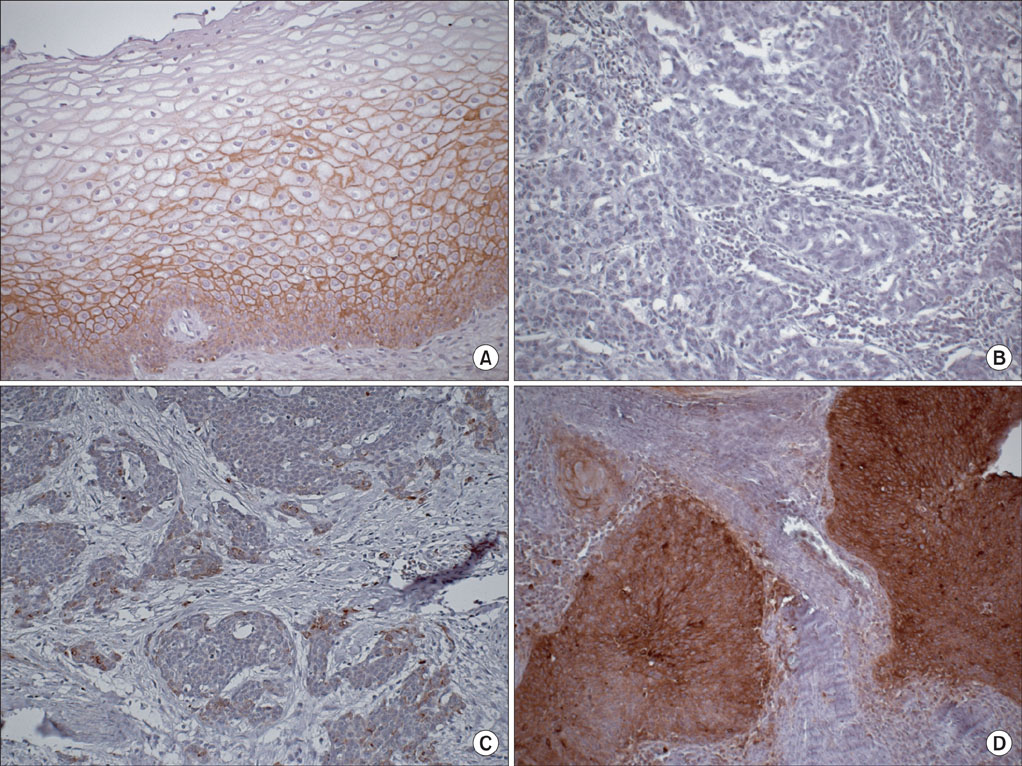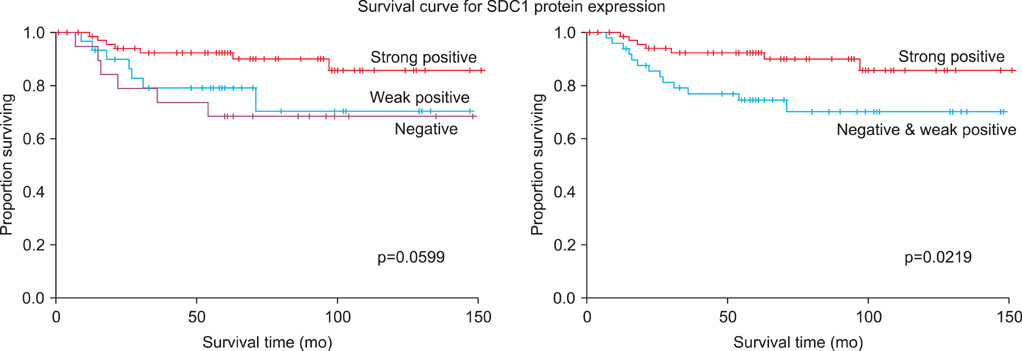J Gynecol Oncol.
2011 Sep;22(3):161-167. 10.3802/jgo.2011.22.3.161.
Prognostic significance of syndecan-1 expression in cervical cancers
- Affiliations
-
- 1Department of Pathology, The Catholic University of Korea School of Medicine, Seoul, Korea. suyoung@catholic.ac.kr
- 2Department of Hospital Pathology, The Catholic University of Korea School of Medicine, Seoul, Korea.
- KMID: 2055703
- DOI: http://doi.org/10.3802/jgo.2011.22.3.161
Abstract
OBJECTIVE
Syndecans are reported to have variable expression in several solid tumors and blood cancers. The cause provoking altered expression of syndecans is not known to date. We studied copy number status of syndecan-1 (SDC1) and significance of SDC1 gene product (syndecan-1, SDC1) expression in cervical cancers.
METHODS
Using 121 cases of cervical cancer tissues, we screened SDC1 expression pattern using immunohistochemistry. We analyzed the relationship between SDC1 expression and clinicopathological parameters. To find possible causes of the expression change, we exploited interphase fluorescent in situ hybridization to screen copy number alteration of SDC1.
RESULTS
Among 121 cases, 101 (83.5%) were positive and 20 (16.4%) were negative for SDC1. Among the parameters, age, histological type, and grade were significantly associated with SDC1 expression (p<0.05). Strong SDC1 expression in the cytoplasm showed better patient survival (p=0.02). In multivariate regression model, grade and SDC1 expression were independent prognostic factors (p<0.05). SDC1 in cervical cancers did not show copy number alteration.
CONCLUSION
Strong SDC1 expression in the cytoplasm of tumor cells predicts better patient survival. The change of SDC1 expression in cervical cancers is not caused by copy number alteration of the gene.
Keyword
MeSH Terms
Figure
Reference
-
1. Moody CA, Laimins LA. Human papillomavirus oncoproteins: pathways to transformation. Nat Rev Cancer. 2010. 10:550–560.2. Cappellen D, De Oliveira C, Ricol D, de Medina S, Bourdin J, Sastre-Garau X, et al. Frequent activating mutations of FGFR3 in human bladder and cervix carcinomas. Nat Genet. 1999. 23:18–20.3. Alberts B, Johnson A, Lewis J, Raff M, Roberts K, Walter P. Molecular biology of the cell. 2008. 5th ed. New York: Garland Science.4. Rapraeger AC. Molecular interactions of syndecans during development. Semin Cell Dev Biol. 2001. 12:107–116.5. Bernfield M, Gotte M, Park PW, Reizes O, Fitzgerald ML, Lincecum J, et al. Functions of cell surface heparan sulfate proteoglycans. Annu Rev Biochem. 1999. 68:729–777.6. Inki P, Jalkanen M. The role of syndecan-1 in malignancies. Ann Med. 1996. 28:63–67.7. Matsumoto A, Ono M, Fujimoto Y, Gallo RL, Bernfield M, Kohgo Y. Reduced expression of syndecan-1 in human hepatocellular carcinoma with high metastatic potential. Int J Cancer. 1997. 74:482–491.8. Kumar-Singh S, Jacobs W, Dhaene K, Weyn B, Bogers J, Weyler J, et al. Syndecan-1 expression in malignant mesothelioma: correlation with cell differentiation, WT1 expression, and clinical outcome. J Pathol. 1998. 186:300–305.9. Nackaerts K, Verbeken E, Deneffe G, Vanderschueren B, Demedts M, David G. Heparan sulfate proteoglycan expression in human lung-cancer cells. Int J Cancer. 1997. 74:335–345.10. Oh JH, Kim JH, Ahn HJ, Yoon JH, Yoo SC, Choi DS, et al. Syndecan-1 enhances the endometrial cancer invasion by modulating matrix metalloproteinase-9 expression through nuclear factor kappaB. Gynecol Oncol. 2009. 114:509–515.11. Davies EJ, Blackhall FH, Shanks JH, David G, McGown AT, Swindell R, et al. Distribution and clinical significance of heparan sulfate proteoglycans in ovarian cancer. Clin Cancer Res. 2004. 10:5178–5186.12. Conejo JR, Kleeff J, Koliopanos A, Matsuda K, Zhu ZW, Goecke H, et al. Syndecan-1 expression is up-regulated in pancreatic but not in other gastrointestinal cancers. Int J Cancer. 2000. 88:12–20.13. Wang H, Leavitt L, Ramaswamy R, Rapraeger AC. Interaction of syndecan and alpha6beta4 integrin cytoplasmic domains: regulation of ErbB2-mediated integrin activation. J Biol Chem. 2010. 285:13569–13579.14. Roh YH, Kim YH, Choi HJ, Lee KE, Roh MS. Syndecan-1 expression in gallbladder cancer and its prognostic significance. Eur Surg Res. 2008. 41:245–250.15. Inki P, Stenback F, Grenman S, Jalkanen M. Immunohistochemical localization of syndecan-1 in normal and pathological human uterine cervix. J Pathol. 1994. 172:349–355.16. Ishikawa T, Kramer RH. Sdc1 negatively modulates carcinoma cell motility and invasion. Exp Cell Res. 2010. 316:951–965.17. Couchman JR. Syndecans: proteoglycan regulators of cell-surface microdomains? Nat Rev Mol Cell Biol. 2003. 4:926–937.18. Numa F, Hirabayashi K, Kawasaki K, Sakaguchi Y, Sugino N, Suehiro Y, et al. Syndecan-1 expression in cancer of the uterine cervix: association with lymph node metastasis. Int J Oncol. 2002. 20:39–43.19. Hasengaowa , Kodama J, Kusumoto T, Shinyo Y, Seki N, Hiramatsu Y. Prognostic significance of syndecan-1 expression in human endometrial cancer. Ann Oncol. 2005. 16:1109–1115.20. Loussouarn D, Campion L, Sagan C, Frenel JS, Dravet F, Classe JM, et al. Prognostic impact of syndecan-1 expression in invasive ductal breast carcinomas. Br J Cancer. 2008. 98:1993–1998.21. Zellweger T, Ninck C, Mirlacher M, Annefeld M, Glass AG, Gasser TC, et al. Tissue microarray analysis reveals prognostic significance of syndecan-1 expression in prostate cancer. Prostate. 2003. 55:20–29.22. Jilani I, Wei C, Bekele BN, Zhang ZJ, Keating M, Wierda W, et al. Soluble syndecan-1 (sCD138) as a prognostic factor independent of mutation status in patients with chronic lymphocytic leukemia. Int J Lab Hematol. 2009. 31:97–105.23. Joensuu H, Anttonen A, Eriksson M, Makitaro R, Alfthan H, Kinnula V, et al. Soluble syndecan-1 and serum basic fibroblast growth factor are new prognostic factors in lung cancer. Cancer Res. 2002. 62:5210–5217.24. Mahtouk K, Hose D, Raynaud P, Hundemer M, Jourdan M, Jourdan E, et al. Heparanase influences expression and shedding of syndecan-1, and its expression by the bone marrow environment is a bad prognostic factor in multiple myeloma. Blood. 2007. 109:4914–4923.25. Mathe M, Suba Z, Nemeth Z, Tatrai P, Fule T, Borgulya G, et al. Stromal syndecan-1 expression is an adverse prognostic factor in oral carcinomas. Oral Oncol. 2006. 42:493–500.26. Juuti A, Nordling S, Lundin J, Louhimo J, Haglund C. Syndecan-1 expression: a novel prognostic marker in pancreatic cancer. Oncology. 2005. 68:97–106.27. Watari J, Saitoh Y, Fujiya M, Shibata N, Tanabe H, Inaba Y, et al. Reduction of syndecan-1 expression in differentiated type early gastric cancer and background mucosa with gastric cellular phenotype. J Gastroenterol. 2004. 39:104–112.28. Rintala M, Inki P, Klemi P, Jalkanen M, Grenman S. Association of syndecan-1 with tumor grade and histology in primary invasive cervical carcinoma. Gynecol Oncol. 1999. 75:372–378.29. Shinyo Y, Kodama J, Hasengaowa , Kusumoto T, Hiramatsu Y. Loss of cell-surface heparan sulfate expression in both cervical intraepithelial neoplasm and invasive cervical cancer. Gynecol Oncol. 2005. 96:776–783.
- Full Text Links
- Actions
-
Cited
- CITED
-
- Close
- Share
- Similar articles
-
- Soluble syndecan-1 (CD138): is it useful as a prognostic factor in Korean patients with multiple myeloma?
- Prognostic Value of TZAP Expression in Various Cancers: TCGA Data Analysis
- The Correlation of Syndecan-1 Expression and Pathologic Risk Factors in Endometrial Carcinoma
- Immunohistochemical Study for Syndecan-1 and Beta-catenin Expression in Basal Cell Carcinoma
- Soluble syndecan-1 at diagnosis and during follow up of multiple myeloma: a single institution study




